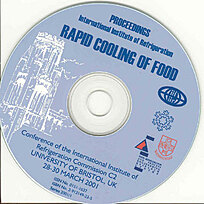
Document IIF
Effet des conditions de refroidissement sur la perte de masse des viandes cuites, au cours d'un refroidissement par circulation lente d'air et d'un refroidissement par air forcé.
Effect of cooling conditions on weight loss of cooked meat during slow air and air blast cooling processes.
Auteurs : WANG L. J., SUN D. W.
Résumé
Weight loss of cooked meat during slow air cooling processes is affected by the cooling conditions such as air velocity, air temperature and relative humidity. Weight loss has been theoretically analysed by an experimentally validated finite element model. The results show that for cooling a large block of cooked meat from the core temperature of 74 to 5 °C (maximum temperature) by air blast cooling method, air velocity has little effect on the total weight loss. The total weight loss increases significantly with the decrease in relative humidity of the air. If the relative humidity is reduced from 92 to 65%, the total weight loss will be increased by 20%. Lower air temperatures produce fast cooling at the surface and thus lower the weight loss greatly. However, air temperature below 0 °C may freeze the surface of the product. The results also show that most of the weight loss occurs at the beginning of the cooling process due to high surface temperature. Therefore, low air temperature can initially be used to accelerate the decrease of the surface temperature near to the freezing point of water, and a higher air temperature can then be used to avoid surface freezing of the products.
Documents disponibles
Format PDF
Pages : 2001-1
Disponible
Prix public
20 €
Prix membre*
Gratuit
* meilleur tarif applicable selon le type d'adhésion (voir le détail des avantages des adhésions individuelles et collectives)
Détails
- Titre original : Effect of cooling conditions on weight loss of cooked meat during slow air and air blast cooling processes.
- Identifiant de la fiche : 2005-1356
- Langues : Anglais
- Source : Rapid Cooling of Food.
- Date d'édition : 28/03/2001
Liens
Voir d'autres communications du même compte rendu (41)
Voir le compte rendu de la conférence
Indexation
-
Thèmes :
Viande et produits carnés;
Aliments préparés - Mots-clés : Vitesse (fluides); Viande; Réfrigeration; Recherche; Air; Produit cuit; Produit carné; Perte de masse; Paramètre
-
Analysis of cooling performance of slow air, ai...
- Auteurs : WANG L. J., SUN D. W.
- Date : 28/03/2001
- Langues : Anglais
- Source : Rapid Cooling of Food.
- Formats : PDF
Voir la fiche
-
Simulation of vacuum cooling process of cooked ...
- Auteurs : WANG L. J., SUN D. W.
- Date : 28/03/2001
- Langues : Anglais
- Source : Rapid Cooling of Food.
- Formats : PDF
Voir la fiche
-
Basic phenomena and consequences.
- Auteurs : KONDJOYAN A.
- Date : 10/1996
- Langues : Anglais
- Source : New Developments in Meat Refrigeration.
- Formats : PDF
Voir la fiche
-
Measurement of water activity of cured-cooked p...
- Auteurs : DELGADO A. E., SUN D. W.
- Date : 28/03/2001
- Langues : Anglais
- Source : Rapid Cooling of Food.
- Formats : PDF
Voir la fiche
-
Cooling of cooked meat: development of predicti...
- Auteurs : JUNEJA V. K.
- Date : 28/03/2001
- Langues : Anglais
- Source : Rapid Cooling of Food.
- Formats : PDF
Voir la fiche
